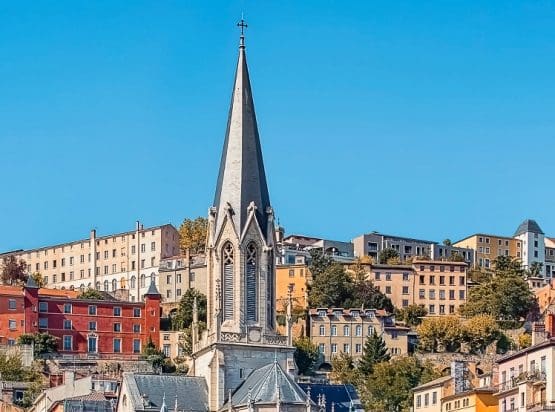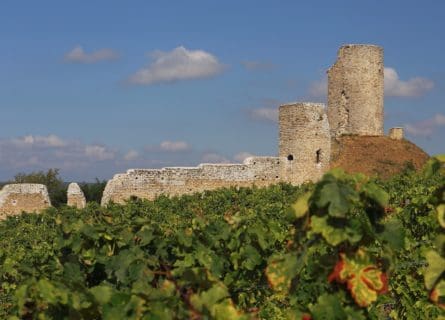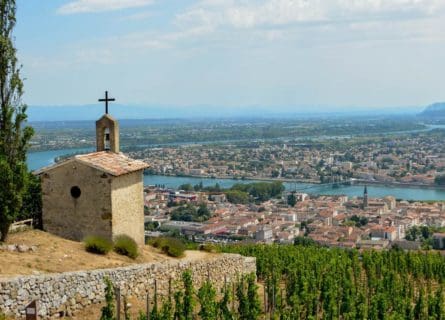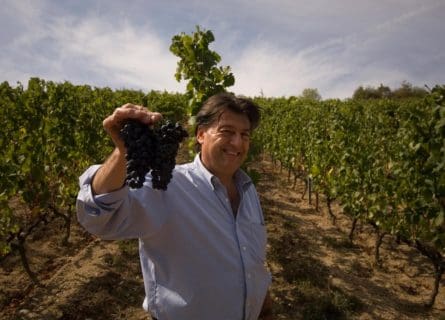Uncover Lyon's vibrant flavors and culinary gems with our expert guides. Plan an unforgettable trip now!
Read more
EXPLORE ALL OUR RHôNE VALLEY WINE REGION GUIDES
Last updated: April 4, 2025
Collectors and oenophiles would place Hermitage in the same category as Latour and La Tache: gloriously complex reds that justify their hype. The vineyards, situated on the eastern bank of the Northern Rhône, yield Syrah wines of incomparable strength, virility, and power.
Yet, the Hermitage has a very close neighbor that also merits further inspection. Crozes-Hermitage may lack the fame of its older sibling, but the wines are excellent and wonderfully affordable. The appellation is far more than simply a pale imitation of Hermitage. It is worthy of the same respect.
Discover More About French Wine

In 43 BC, the Roman military colony of Lugdunum (Lyon) was founded. From there, Roman soldiers and administrators oversaw a vast and strategically important province called the Three Gauls. Merchants and artisans flocked to the settlement while farmers planted vines along the steep banks of the northern Rhône.
Meanwhile, the Western Roman Empire continued to expand at an astounding rate – at the height of its power, over a quarter of the world’s population owed allegiance to the Caesars.
Decline of the Roman Empire and Rise of the Burgundians
However, this vast political project was fated to collapse; rival civilizations became bolder in their attacks in the 4th century AD while Rome’s authority waned. By 476 AD, the Western Roman Empire had completely disintegrated into anarchy. Several decades earlier, the Burgundians laid siege to the northern Rhône, launching a takeover bid for the city of Vienne (located north of Crozes-Hermitage) in 438.
Yet the Germanic Franks, led by Clovis I, had no intention of allowing Vienne to fall into enemy hands. His successors were pivotal in creating the Holy Roman Empire, pacifying French territories, and conquering great swathes of northwest Italy. Charles II the Bald handed control of the northern Rhône to Comte Boso of Provence in the 800s. However, it was absorbed into the Holy Roman Empire in 1032.
Economic Evolution in the Rhône Valley
In the late Middle Ages, competing factions contested the Rhône Valley and neighboring Alps. Indeed, the houses of Savoy, the Dauphine, and Provence could all raise formidable armies; territories were constantly occupied and retaken during this violent period.
Many centuries later, Lyon had become one of Europe’s leading textile centers, while the advent of the railway opened up new markets for the wines of Crozes-Hermitage. The Industrial Revolution bombarded the city with heavy industry, although the phylloxera epidemic devastated countless vines in the late 1800s.
Fortunately, winegrowers discovered that American rootstock was immune to the louse’s poisonous bite, so a major regrafting program took place in the early 20th century. In 1937, Crozes-Hermitage received its appellation, and its geographical boundaries expanded in 1952 to meet the growing international demand.

Located in southeastern France, the spectacular northern Rhône region is home to several important red wine appellations, including Crozes-Hermitage. The vineyards stretch 10 miles north and south of the villages of Tain and Hermitage, with Crozes located to the north of the Hermitage appellation boundaries.
The area under vine has expanded considerably in the 21st century, as exorbitant land prices encouraged investors to target less prestigious appellations. As of 2023, farmers have planted over 1800 hectares, encircled by picturesque cherry orchards that bestow a timeless and uniformly tranquil quality upon the landscape.
Diverse Terroir of Crozes-Hermitage
However, the terroir is far from homogeneous. Generally, the northern half of the zone, with its loess soils, produces the most fruit-forward, structured, and bright styles, while further south features flatter terrain and lower altitude.
The alluvial plain south of the village can occasionally be too fertile for high-quality wine production, although certain growers are regrettably happy to overlook that fact. The trademark style of the southern half of Crozes-Hermitage is soft and approachable red wines with black fruit and moderate acidity. A small amount of white wine is also produced in the appellation, based on a marriage between Marsanne and Roussanne.

Unlike Hermitage and Côte Rôtie, Crozes-Hermitage does not have a longstanding culture of incorporating white varieties into red blends. True, a small percentage of white grapes can be used, yet most Crozes-Hermitage is built around at least 90-95% Syrah.
Thus, because this noble red grape reigns unchallenged and is a variety that usually has intense color and flavor, the winemaking choices are arguably less important than the differences in terroir and vintage. As to the latter point, a succession of very warm years produced some coarse and alcoholic reds: forgettable, soapy, and blowzy wines.
Fortunately, growers are becoming more adept at dealing with climate change in the Rhône; better canopy management, earlier harvests, and site selection are all possible solutions. Freshness, balance, and poise should be the key objectives in Crozes-Hermitage, rather than high alcohol and lush concentration.
Adapting Winemaking Techniques for Quality and Character
Therefore, many producers are marketing soft and fruity red wines for early drinking, made using the carbonic maceration technique that is very popular in Beaujolais. However, if a winemaker desires a more ‘serious red,’ a number of houses use the technique of crushing whole grape bunches with their stems through automatic pigeage (punch down). Ripe stems add structure to the wine, enhanced by maturation in wood.
But before that can happen, the critical mass are now vinifying their wines in stainless steel: cool fermentations yield a very expressive and fresh style of red. Yet the traditionalists are strongly attached to oak vats and concrete, utilizing an extended maceration (over three weeks) to produce a deeply colored and structured expression of the Syrah grape.
Achieving Excellence and Misleading Experts
Tasted blind, the best labels can fool critics into believing that Hermitage is sitting in their glass. Top cuvées will balance approachability with structure, offering aromas of dark fruit, garrigue, pepper, and a touch of damp earth. The palate should be generous but not one-dimensional, supported by firm yet ripe tannins. Freshness and vibrant acidity are obligatory elements in all good Crozes-Hermitage.
Why give Crozes-Hermitage the time of day? After all, the appellation lacks the cachet of Côte Rôtie and the global renown of Hermitage. These wines are not collectors’ items – they do not electrify auction houses and investor portfolios. From one perspective, we can just ignore this sizable vineyard altogether.
Quality and Accessibility
But please don’t write off Crozes-Hermitage – at least not yet. Consider first the reality of purchasing blue chip labels from the northern Rhône, wines that have disappeared into the luxury goods category. Limited volumes plus intense demand can equal a hefty price tag.
Meanwhile, Crozes-Hermitage remains perfectly realistic, indeed good value compared with the international competition. Moreover, there is an immediacy to (most) Crozes-Hermitage that is very appealing: the critical mass of wines are supple, seductive, and ideal with food. A hat-trick of very dry vintages yielded a plethora of voluptuous, meaty reds, perhaps more New World in style than we might expect. The only concern is the age-ability of such wines due to their relatively high alcohol and glossy tannins.
The Appeal of Crozes-Hermitage: Versatile and Pleasurable
Of course, not every wine style has to be ‘serious,’ and not every occasion demands a First Growth. Infused with youthful, supple red fruit, Crozes-Hermitage has become a real crowd-pleaser. White Crozes-Hermitage can also be exceptional, albeit challenging to find, as relatively little is exported.
Jean-Luc Colombo produces a very good example, typically based on equal parts Marsanne and Roussanne. Its decadent flavors of honeysuckle, white flowers, and tarte au citron are moreish beyond belief. The style is rarely expensive, yet it can rival the best Hermitage Blanc. An unbeatable price-to-quality ratio at the heart of the northern Rhône? You heard it here first.
Uncover the allure of Marsanne grape variety. From its traditional role in Rhône blends to the new wave of single-varietal Marsanne wines.
Find out moreLearn about Roussanne, the elegant white grape native to Rhône. Often blended with Marsanne, explore its unique qualities and rich heritage in our guide.
Find out moreSyrah is dark-skinned and perhaps the most underrated of the 'noble' red grape varieties.
Find out moreYou’ll dine like Louis XVI in Lyon, a city easily accessible from Crozes-Hermitage. This is the French gastronomic capital, after all, with a flurry of big-name chefs behind an eclectic restaurant line-up that embraces all genres, be it formal, Michelin-starred, or decidedly rustic.
Yet many of the best meals are found in the bouchons – casual bistros serving classical dishes in a fun atmosphere. Savor pieds de couchon (pig’s trotters) and boudin blanc (veal sausage) while your waiter selects a killer bottle of Crozes-Hermitage.
A Gastronomy Guide to Lyon Cuisine: Read more
If you would like us to customize an exclusive luxury tour, contact us and let us know your travel plans. We offer luxury food and wine tours for private groups of a minimum two guests. In addition, all of our private, chauffeured tours are available year-round upon request.

